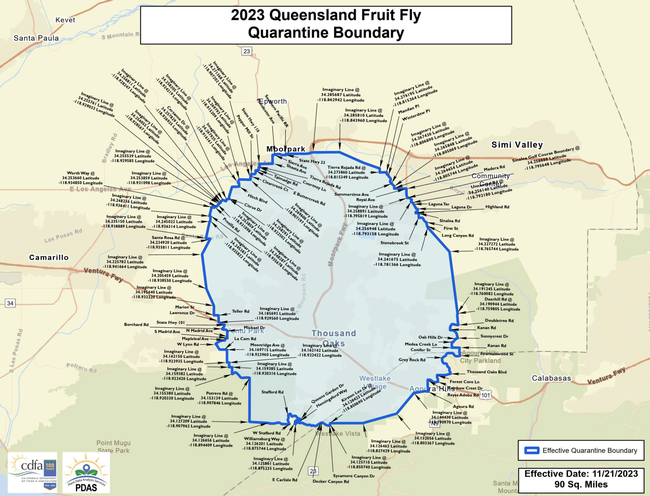Queensland fruit fly quarantine?
Growers should consider the pre-quarantine program.
The Queensland fruit fly quarantine zone has been expanded (see: https://www.cdfa.ca.gov/plant/qff/regulation.html). Queensland fruit fly (also called QFF or Qfly) is a concern because it has over a hundred host plants and causes severe fruit damage. Like other tephritid fruit flies, it is challenging to control once the population takes hold.
What does this mean for growers in the quarantine zone? If a grower is in the zone (regardless of if they have Qfly on their ranch), their crop is on hold for one life cycle. Based on the weather, the life cycle length can vary. In the winter, life cycles are generally around 90 days. In the summer, the life cycle is about 30 days. Growers can view the length of the fruit fly life cycle here to determine how long the holding period is: https://www.cdfa.ca.gov/plant/pe/InteriorExclusion/pdf/QFF_Ventura_County-Thousand%20Oaks-2023-2024PreharvestTreatmentSchedule.pdf
During this holding period, growers must treat their crop repeatedly until the holding period expires. Growers must treat with Malathion + NuLure every 6-14 days for the duration of the holding period. This is a bait spray that must be mixed. To use Malathion, growers will need to notify the county ag commissioner and will need to register for special local need usage. For an additional option, growers can instead use GF-120 Spinosad bait every 7-10 days. GF-120 is premixed and therefore easier to use, but costs more than Malathion. When selecting which bait to use, growers should consider PHI for their crop and harvesting intervals. For example, GF-120 has a 4 hour PHI and Malathion has a 3 day PHI for strawberries – if a grower is harvesting every week, they may want to use GF-120. Growers need to spray bait around the perimeter of each field and throughout the field at spaced intervals.
Growers must comply with the treatment intervals, or they will have to start the holding period over.
After treatment, growers will receive a permit that is valid for 10 days and allows for movement of the crop.
If a grower is near the quarantine zone and anticipates economic losses due to a long holding period should they fall under quarantine, they can voluntarily opt to join a pre-quarantine program. The pre-quarantine program is overseen by the county. Treatments applied during the pre-quarantine period count towards the holding period if a grower falls under quarantine later on. This reduces the amount of time that the crop is on hold. This is a proactive measure that is optional. Please direct questions about the pre-quarantine program to the pest exclusion program at the Ventura County's Agricultural Commissioner's Office (806-388-4222 ext. 7165) or UC ANR at hcohen@ucanr.edu
Quarantine regulations apply to most crops within the quarantine zone, but 'Hass' avocado has been excluded from the host list for Queensland Fruit Fly and Oriental Fruit Fly and is not subject to quarantine regulations
More complete information regarding the mitigations required for citrus movement may be found on the Citrus Grower/Grove Manager Information page: https://phpps.cdfa.ca.gov/PE/InteriorExclusion/pdf/acpgrowerinformation.pdf
